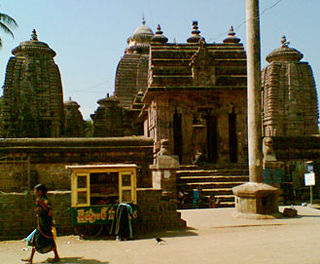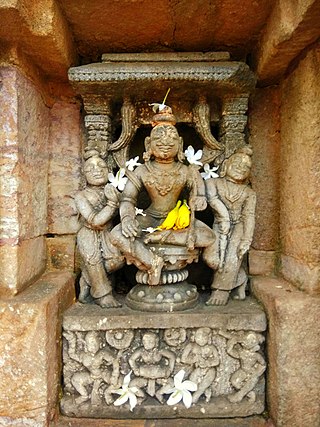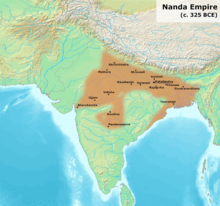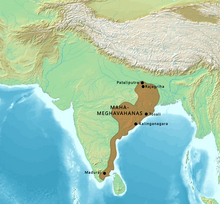
The history of Odisha begins in the Lower Paleolithic era, as Acheulian tools dating to the period have been discovered in various places in the region. The early history of Odisha can be traced back to writings found in ancient texts like the Mahabharata, Maha Govinda Sutta and some Puranas. The region was also known to other kingdoms in region of East Indies due to maritime trade relations.
The Gajapati Empire, was an empire established by the Suryavamsa dynasty or Routray dynasty, who were a medieval Hindu dynasty in the Indian subcontinent. It originated in the region of Trikalinga and reigned from 1434 to 1541 CE. It succeeded the reign of the Eastern Gangas. Under the Emperor Kapilendra Deva, the Gajapati empire stretched from lower Ganga in the north to Kaveri in the south.

Mukhalingam, also known as Srimukhalingam or Mukhalinga, is a village panchayat in Jalumuru mandal of Srikakulam district in the Indian state of Andhra Pradesh. Historically known as Kalinganagari, Mukhalingam served as the capital of Eastern Ganga Dynasty from 6th century AD to 12th century AD. Emperor Sri Ananthavarma Chodaganga Devara conquered Utkala in 1122 AD and shifted the capital from Kalinganagari to Caudwara kataka

North Andhra or Uttara Andhra, also known as Kalinga Andhra, is a geographic region in the Indian state of Andhra Pradesh. It is between the Eastern Ghats and the coast of the Bay of Bengal. It comprises six northern districts of the state, Srikakulam, Parvathipuram Manyam, Vizianagaram, Visakhapatnam, Alluri Sitharama Raju and Anakapalli. As of 2011 census of India, the region with six districts has a population of 9,338,177.
Western Odisha is the western part of the state of Odisha in India, extending from the Kalahandi district in the south to the Sundargarh district in the north.

The Eastern Ganga dynasty were a large medieval era Indian royal Hindu dynasty that reigned from Kalinga from as early as the 5th century to the mid 20th century. Eastern Gangas ruled much of the modern region of Odisha in three different phases by the passage of time, known as Early Eastern Gangas (493–1077), Imperial Eastern Gangas (1077–1436) and Khemundi Gangas (1436–1947). They are known as "Eastern Gangas" to distinguish them from the Western Gangas who ruled over Karnataka. The territory ruled by the dynasty consisted of the whole of the modern-day Indian state of Odisha, as well as major parts of north Andhra Pradesh, parts of Chhattisgarh and some southern districts of West Bengal. Odia language got official status in their regime following the evolution of the language from Odra Prakrit. The early rulers of the dynasty ruled from Dantapuram; the capital was later moved to Kalinganagara, and ultimately to Kataka and then to Paralakhemundi.

Gajapati Langula Narasingha Deva I was an Eastern Ganga monarch and a warrior of the Kalinga region who reigned from 1238 CE to 1264 CE. He defeated the Muslim forces of Bengal who constantly threatened the Eastern Ganga dynasty's rule over his kingdom of Kalinga from the times of his father Anangabhima Deva III. He was the first king from Kalinga and one of the few rulers in India who took the offensive against the Islamic expansion over India by Turko-Afghan invaders of Eastern India. His father had successfully defended his kingdom against the Turko-Afghan rulers of Bengal and crossed into Rarh, Gauda and Varendra in Bengal chasing the invaders on backfoot. He became the dominant ruler of the peninsula by defeating the Turko-Afgan, Gouda, and the powerful monarch of the south kakatiya Dynasty king Ganapati Deva, and was one of the most powerful Hindu rulers in India. He also built the Konark temple to commemorate his victories over the Muslims as well as other temples and the largest fort complex of Eastern India at Raibania in Balasore. He also built famous Varaha Lakshmi Narasimha Temple at Simhachalam, Andhra Pradesh. The Kendupatana plates of his grandson Narasingha Deva II mention that Sitadevi, the queen of Narasingha Deva I was the daughter of the Paramara king of Malwa.
Dandabhukti was an ancient and medieval territory located between the two rivers, Dwarakeswar and Subarnarekha, and situated in the Rarh region of the ancient Bengal. It covered the present-day districts of Bankura, Hooghly, Paschim Medinipur, and Purba Medinipur in West Bengal, India.

The Maritime history of Odisha, known as Kalinga in ancient times, started much before 800 BC according to early sources. The people of this region of eastern India along the coast of the Bay of Bengal sailed up and down the Indian coast, and travelled to Indo China and throughout Maritime Southeast Asia, introducing elements of their culture to the people with whom they traded. The 6th century Manjusrimulakalpa mentions the Bay of Bengal as Kalingodra and in ancient Classical India, the Bay of Bengal was known as Kalinga Sagar, indicating the importance of Kalinga in the maritime trade. The old traditions are still celebrated in the annual Boita Bandana festival including its major celebration at Cuttack on the banks of Mahanadi river called Bali Jatra, and are held for seven days in October-November at various coastal districts, most famous at Cuttack though.

Kapilendra Deva was the founder of the Suryavamsa Gajapati Empire that ruled parts of eastern and southern India with the present-day Odisha as the center of the empire. He ascended to the throne after staging a military coup against the preceding and the last ruler from the Eastern Ganga dynasty, Bhanu Deva IV. He is also referred to as Kapilendra Routray or Sri Sri Kapilendra Deva. Kapilendra claimed descent from the Surya Vamsha of the Mahābhārata and was conferred the regnal title Shri Shri ...(108 times) Gajapati Gaudeshwara NabaKoti Karnata Kalabargeswara i.e. the Lord of Bengal (Gauda), the lord of the Karnataka region or Vijayanagara, the Lord of Kalaburagi and of nine crore subjects.

Gangesvara Anantavarman Chodaganga Deva was an Eastern Ganga monarch who reigned between 1077 CE to 1150 CE.He was a great patronage of art and architecture who built many temples one of being the magnificent jagannath temple puri He was the ruler of the Kalinga region from river Ganga to Godavari, and later the early medieval Odisha region with the incorporation of the constituent regions with the decline of the Somavamshis.

The Bhanja dynasty is a dynasty that originated in the northern and central regions of modern Odisha before the Gupta Empire became an imperial power. The dynasty, of ancient local Kshatriya lineage as documented by Hermann Kulke, succeeded the Vindhyatabi branch of the Nagas of Padmavati, who ruled from the Keonjhar district of Odisha and included Satrubhanja of the Asanpat inscription. The Bhanj later became feudatories of the Bhauma-Kara dynasty.
The Mathara dynasty ruled in the Kalinga region of eastern India during 4th and 5th centuries CE. Their territory included parts of the area between the present-day Ganjam district of Odisha in north and the Srikakulam district in Andhra Pradesh in the south. They appear to have been overthrown by the Pitrbhakta dynasty.
The Pitrbhakta dynasty ruled in the Kalinga region of eastern India in the fifth century CE. Their territory included parts of the present-day northern Andhra Pradesh and the southern Odisha. They probably overthrew the Mathara dynasty.
The Bhauma dynasty, also known as Kara dynasty, ruled in eastern India between 8th and 10th centuries. Their kingdom, called Toshala, included parts of present-day Odisha.

The Bhoi dynasty or the Yaduvamsa rajput dynasty were a medieval Hindu dynasty from the Indian subcontinent, which originated in the region of Odisha that reigned from 1541 to 1560 CE. Govinda Vidyadhara had usurped the throne from the later weaker Suryavamsa Gajapati Empire rulers as the kingdom started weakening but had a short-lived reign as ruling chiefs of Odisha as the ensuing internal rivalries and constant threats of invasions rendered them weak and were eventually overthrown by Mukunda Deva of Chalukya dynasty in 1560.
Gajapati Rāmachandra Deva I was the founder of the Bhoi dynasty of Khurda in Odisha, India. He became the ruler of Khurda kingdom after defeating Mukunda Deva in 1568. He claimed descent from the Yaduvanshi dynasty which features prominenetly in the Indian epic, Mahabharata. The Odia populace gave him the title of "Thakura Raja" as a mark of respect for renovating the damaged Hindu temples that were destroyed by the invasion of Kalapahad. He was titled as Vira Sri Gajapati Viradhi Viravara Pratapi Ramachandra Deva.
Trikalinga is a region of central-east India, mentioned in several historical sources. Its identification and its relation to the term "Kalinga" is debated among modern historians, who variously identify it as a distinct region to the west of Kalinga, a larger region comprising Kalinga and two other regions, a constituent of the greater Kalinga, or the three divisions of Kalinga proper.
Gajapati is a regnal title from the region of modern Odisha in the Indian subcontinent. The word ‘Gajapati’ in Odia refers to "Gaja" meaning elephant and "Pati" meaning master or husband. Thus Gajapati etymologically means a king with an army of elephants. The institution of Gajapati kingship as a title was used by the Eastern Ganga dynasty and was used by succeeding dynasties, as Gajapati dynasties, with the patronisation of Lord Jagannatha as the imperial deity of the Odia cultural realm. Four ruling dynasties have been part of Gajapati kingship or dynasties.

















